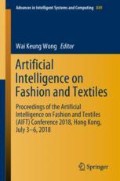Abstract
Due to the subjective characteristics and rapid change of fashion style, it is relatively hard to predefine the style feature in style classification systems. In this paper we present a cognitive characteristics based clothing style autonomous development model. By the addition of special domain related information to the classic itti visual attention model, we achieve the multi-object attention model of the clothing style. And based on this we implemented the autonomous development of clothing style recognition by Multi-Layer In-place Learning Network (MILN in short). Experiments prove the feasibility and effectiveness of our model.
Access this chapter
Tax calculation will be finalised at checkout
Purchases are for personal use only
References
Huang, Q., Sun, S.: The research progress for the calculation in product styles. J. Comput. Aided Des. Comput. Graph. 18, 1629–1636 (2006)
Chan, C.-S.: Can style be measured. Des. Stud. 21, 227–291 (2000)
Feng, L., Liu, X.: First exploration of the ways to quantify clothing styles. J. Donghua Univ. (Nat. Sci.) 30(1), 57–61 (2004)
Weng, J., Luwang, T., Lu, H.: A multilayer in-place learning network for development of general invariances. Int. J. Humanoid Rob. 4(2), 281–320 (2007)
Robert, J., Laurent, I.: Beyond Bottom-up: incorporating task-dependent influences into a computational model of spatial attention. In: IEEE Conference on Computer Vision and Pattern Recognition, pp. 1–8 (2007)
Huang, Q., Sun, S.: The recognition method for product styles based on matching features. China Mech. Eng. 14, 1836–1838 (2003)
Weng, J., Luciw, M.: Dually optimal neuronal layers: lobe component analysis. IEEE Trans. Auton. Ment. Dev. 1(1), 68–85 (2009)
M, W., M, T.: Cognitive Psychology: A Student’s Handbook, 6th ed., Psychology Press (2010)
Chen, J.: Researches for the mode of style operation which is used to design product style. Ind. Des. 28, 111–115 (2000)
Cheng, G., Li, J.: Research on clothing style preference model based on interactive genetic algorithm. Comput. Appl. Softw. 28(2), 229–231 (2011)
Author information
Authors and Affiliations
Corresponding author
Editor information
Editors and Affiliations
Rights and permissions
Copyright information
© 2019 Springer Nature Switzerland AG
About this paper
Cite this paper
Li, J., Zhong, X. (2019). Cognitive Characteristics Based Autonomous Development of Clothing Style. In: Wong, W. (eds) Artificial Intelligence on Fashion and Textiles. AITA 2018. Advances in Intelligent Systems and Computing, vol 849. Springer, Cham. https://doi.org/10.1007/978-3-319-99695-0_11
Download citation
DOI: https://doi.org/10.1007/978-3-319-99695-0_11
Published:
Publisher Name: Springer, Cham
Print ISBN: 978-3-319-99694-3
Online ISBN: 978-3-319-99695-0
eBook Packages: Intelligent Technologies and RoboticsIntelligent Technologies and Robotics (R0)

